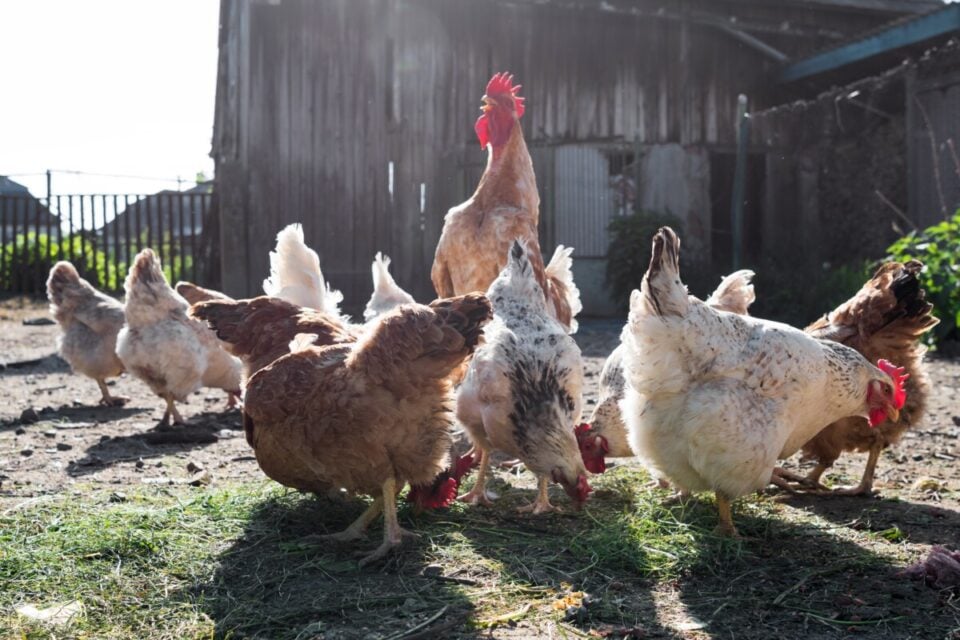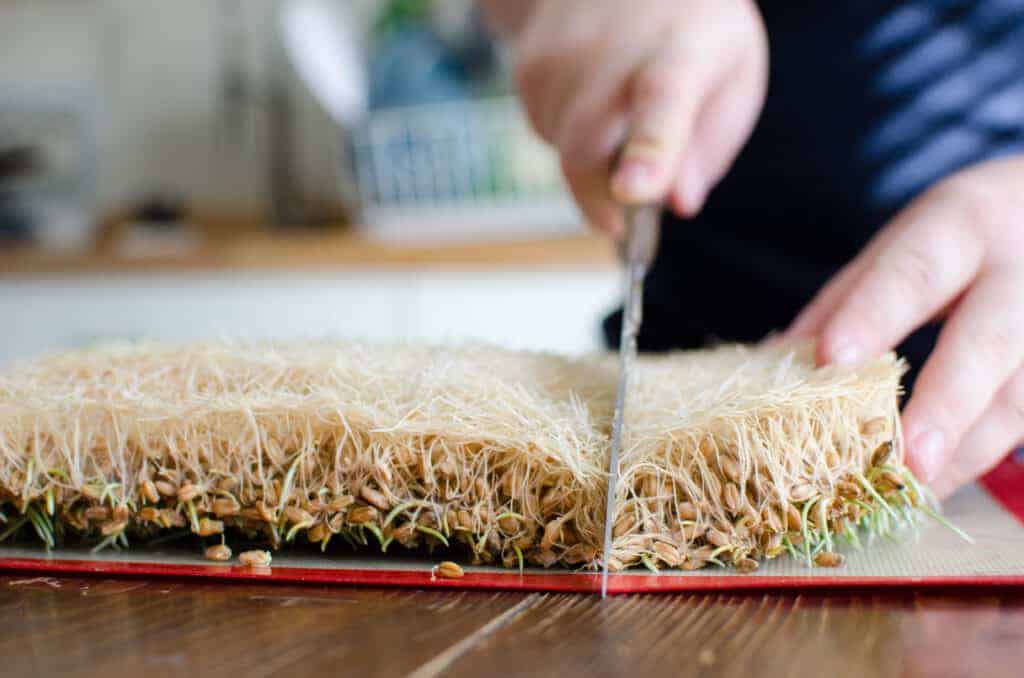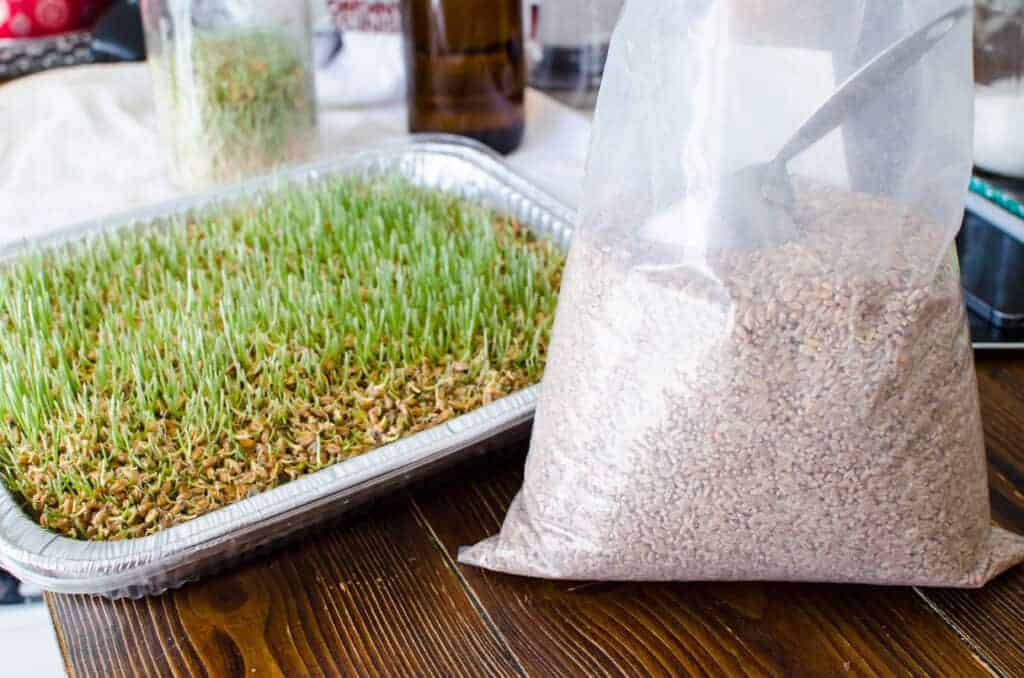Have you been thinking about growing fodder for your chickens but aren’t sure exactly how much to feed them? You’re not alone! As a homesteader who’s been raising chickens for years, I’ve experimented with different feeding methods, and fodder has become one of my favorites – especially during winter when fresh forage is limited.
In this guide I’ll break down everything you need to know about feeding fodder to your chickens – from how much each bird needs to how to grow your own chicken fodder system at home. Let’s dive in!
What Is Fodder and Why Feed It to Chickens?
Fodder refers to sprouted grains that are harvested and fed to livestock after just a few days of growth. When you sprout grains like wheat barley, oats or rye, something amazing happens – they become about 40% more digestible for your chickens!
The sprouting process increases the nutritional value significantly, transforming simple grains into vitamin and mineral-packed live food. Plus, my chickens go absolutely crazy for it!
Benefits of Feeding Fodder to Your Flock
Before we get into specific amounts, let’s look at why fodder is so great for chickens:
- Higher nutrition: Sprouted grains have increased protein, fiber, vitamin, and mineral content
- Cost savings: You can grow fodder with minimal space and resources
- Year-round fresh greens: Even in winter when pasture isn’t available
- Environmental enrichment: Chickens love pecking at and playing with fresh sprouts
- Sustainability: Growing fodder produces very little waste
- Better digestion: Sprouted grains are easier for chickens to digest
How Much Fodder Should You Feed Per Chicken?
Here’s the information you’ve been waiting for! The general rule of thumb is that chickens need approximately 2-3% of their body weight in fodder per day if you’re only feeding fodder (not commercial feed).
To break this down more specifically:
- A 5-pound chicken will eat about 3-4 ounces of fodder daily
- Chicks (1-8 weeks): 0.1-0.25 oz per chick
- Pullets (8-20 weeks): 0.25-1.5 oz per pullet
- Mature hens: 2-4 oz per hen
- Roosters: 3-5 oz per rooster
However, these amounts can vary based on several factors:
Factors Affecting Fodder Consumption
- Age: Younger birds typically need more feed relative to their body weight
- Production status: Laying hens need more nutrition than non-laying birds
- Weather: Chickens eat more during cold weather to maintain body temperature
- Supplementation: If you’re also providing other feeds, they’ll eat less fodder
- Pasture access: Free-ranging chickens might eat less fodder
- Health: Sick or stressed chickens may reduce feed consumption
One homesteader with 12-15 birds in their flock reported feeding about a 12×14 inch tray of fodder every day or so during winter months. They mentioned that their current flock seemed to prefer younger sprouts, so they harvested at 5-6 days rather than 7-8 days.
How to Grow Your Own Chicken Fodder
Growing fodder is surprisingly simple! Here’s what you’ll need to get started:
Supplies for Growing Chicken Fodder
- Shallow containers (plant growing trays work great)
- Grains of choice (wheat, barley, oats, or rye)
- Non-chlorinated water
- Spray bottle (optional)
- Shelving (optional for larger batches)
- Grow lights (optional)
Step-by-Step Fodder Growing Process
- Soak your grains in a food-grade bucket overnight to jumpstart germination
- Prepare your containers – use shallow trays with drainage holes
- Spread the soaked grains in the trays, no more than 2 inches thick (I just add enough so I can’t see the bottom of the tray)
- Rinse and drain daily – keep grains moist but not soaking wet
- Place in a sunny location or under grow lights
- Harvest when ready – usually 3-7 days, when sprouts are 2-6 inches tall
- Cut into manageable pieces and feed to your chickens
To maintain a constant supply, start new trays every 2-3 days. This creates a rotation system where you always have fresh fodder at different growth stages.
Setting Up a Rotational Fodder System
If you want to have fodder available all the time, you’ll need to create a rotational growing system. Here’s how I do it:
- Make multiple trays on day one
- Start new trays every 2-3 days
- As older trays reach harvest stage, new ones are just starting
- Continue this cycle for a constant supply
You can make this as simple or complex as you want. Some folks just grow small batches in a sunny window during winter, while others set up entire shelving systems with grow lights for year-round production.
Troubleshooting Common Fodder Problems
Even with such a simple system, you might encounter a few issues:
- Grains not sprouting: Try increasing rinse frequency, using warmer water, adding a light source, or ensuring grains aren’t spread too thickly
- Moldy fodder: Improve air circulation and drainage, rinse more frequently, don’t overload trays
- Poor growth: Rinse consistently, use fresher seeds, consider adding a tiny bit of fertilizer to soaking water
- Leggy sprouts: Provide more light during sprouting for shorter, sturdier growth
- Low consumption: Introduce fodder slowly, mix with preferred feeds, adjust amounts
Feeding Strategies for Fodder
You don’t have to rely exclusively on fodder. Here are some ways to incorporate it into your feeding regimen:
- Free-choice supplement: Offer alongside regular feed
- Partial replacement: Use fodder to replace up to 50% of organic layer feed
- Mix with other feeds: Combine with whole grains or scratch
- Enhanced feed: Blend fodder into commercial mash or crumbles
- Complement to kitchen scraps: Mix with chopped veggies and fruits
When first introducing fodder, start with small amounts and gradually increase as your chickens become accustomed to it. Some chickens might be hesitant at first, but most will quickly learn to love it!
Cost Considerations
One of the great things about fodder is that it’s incredibly cost-effective. Here’s a rough breakdown:
- Basic fodder system setup: $30-60
- Grain seeds: $15-30 per 25 lbs
- Daily water usage: 5-10 gallons
- Time investment: Less than 30 minutes per day
The real magic happens when 1 pound of dried grain transforms into approximately 7 pounds of nutritious fodder! This multiplication effect means you’re getting significantly more feed value from your investment.
Final Thoughts on Fodder Feeding
While fodder is a fantastic addition to your chickens’ diet, it’s worth remembering that putting your birds on pasture is still the best option when space and weather allow. Fodder acts as an excellent pasture replacement during winter months or when free-ranging isn’t possible.
If you’re short on time or space, you can even try sprouting grains in a mason jar! Simply soak them daily in water, drain well, and watch them grow. This “mini-fodder” can be a great way to test the concept before committing to a larger system.
Remember to always provide grit, minerals, and vitamin supplements alongside your fodder, especially if you’re using it as a primary food source.
Have you tried growing fodder for your chickens? How much do you feed your flock? I’d love to hear about your experiences in the comments below!
FAQ About Chicken Fodder
Can chickens live off fodder alone?
Yes, chickens can live off fodder as a complete food source when provided alongside necessary grit, minerals, and vitamin supplements. However, many chicken keepers use it as a supplement rather than a complete replacement for commercial feed.
What is the 90-10 rule for chickens?
This rule suggests that 90% of a hen’s diet should consist of high-quality, complete layer feed, with the remaining 10% coming from healthy supplements like organic scratch grains, oyster shells, fresh vegetables, herbs, and bugs.
How do I calculate how much fodder I need?
Multiply your chickens’ average live body weight by the number of animals you have, then multiply by 0.02 to find how much fodder you would need daily in pounds.
What grains are best for chicken fodder?
Wheat, barley, oats, and rye all make excellent fodder for chickens. You can use a single grain or a mixture depending on what’s available and affordable in your area.
How long does it take to grow fodder?
Fodder is typically ready to harvest in 3-7 days, depending on the temperature of your home and where the fodder is located. Warmer temperatures typically result in faster growth.
Remember, growing fodder can be as simple or as complicated as you want it to be – there’s no right or wrong way as long as you’re providing nutritious sprouts for your flock!

Steps to Growing Chicken Fodder
You can make chicken fodder as simple or as complicated as you’d like it to be. Some people just grow small batches of fodder for chickens in a sunny window during the winter months—while other people grow huge trays of fodder on large shelving racks with grow lights all year long.
That part is up to you—but the growing part is the same across the board. You’ll need just a few things to get started.
What you’ll need to grow fodder:
- Shallow container (I like these plant growing trays)
- Grains of choice (listed above)
- Water (non-chlorinated)
- Spray bottle (optional)
- Shelving (optional—if you’re doing large batches)
- Grow lights (optional)
Soak your grains of choice in a food grade bucket or bowl overnight. This will jumpstart the process.
Find a sturdy container, like these plant trays, as your base for your fodder. Old plastic or metal cake pans work well. If there are no holes in the bottom, drill lots of little holes in the bottom—big enough to allow water to drain, but small enough so that the grains don’t escape when watered. You may have to place a plastic mesh liner in the bottom of the pan if your holes are too big.
Add your soaked grains to the pan, no more than 2 inches thick. I like to add just a thin layer until I can’t see the bottom of the pan any longer. Give them a nice big water under the spigot, and then let them drain before setting them in their permanent place.
Keep the grains moist, but not soaking wet, until they begin to sprout. You can do this by using a spray bottle with water, or by simply running the fodder under water each day and allowing it to drain fully. Make sure you’ve set them in a sunny place so they grow quicker.
If you want to grow them more uniformly, you can use a grow light system.
If you want the grains to drain (instead of using the spray bottle), you might consider placing a drain pan or cookie sheet under them.

After 3-7 days, your fodder will be sprouting nicely, depending on the temperature in your home or where the fodder is located. Once the fodder reaches the desired length, flip it upside down onto a clean surface and cut from the bottom, where the roots are. Make 4 inch squares, or desired size, and offer to your chickens as needed!
Fodder can take a few tries to master, but once you’ve mastered it, you’ll begin putting together a constant rotational system that suits your needs.
While fodder is great, putting your chickens on pasture most of the year is your best option, if space allows. Fodder acts as a pasture replacement when pasture raising isn’t an option, or isn’t available during cold months.
If you don’t have time or space to make fodder, try sprouting wheat, broccoli, peas, or other grains and veggies in a mason jar! Simply soak them everyday in water, drain well, and watch them grow.
What Grains Can You Use to Grow Chicken Fodder?
When growing fodder for chickens, there are a few different grains you can use for sprouting. You can use just one of these grains, or a mixture of them, for your chicken fodder.
Grains you can use for fodder include:
All grains become 40% more digestible when sprouted, soaked, or turned into fodder for chickens. Your chickens will need to consume less chicken fodder than the amount of regular feed that they regularly eat simply because the nutritional value is higher. The absorption rate of the fodder into the chicken’s system is also greater and more efficient.
To learn how much feed chickens actually eat, you can read my “How Much Feed Do Chickens Eat?” blog post linked here.
Chickens need 2-3% of their body weight in fodder each day, if you’re only feeding fodder (not feed) daily. Offer it along with their grit, mineral, and vitamin supplements.

